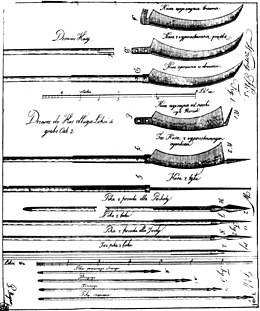What Is Picot Used For

Illustration from Chrystian Piotr Aigner'southward "Krótka nauka o kosach i pikach" ("A Brief Treatise on Scythes and Pikes"), 1794
A war scythe or military machine scythe is a grade of pole weapon with a curving unmarried-edged blade with the cutting edge on the concave side of the bract. Its blade bears some superficial resemblance to that of an agricultural scythe from which it likely evolved, but the state of war scythe is otherwise unrelated to agricultural tools and is a purpose-built infantry melee weapon. The blade of a war scythe has regularly proportioned flats, a thickness comparable to that of a spear or sword blade, and slightly curves along its edge every bit it tapers to its point. This is very unlike from farming scythes, which have very thin and irregularly curved blades, specialised for mowing grass and wheat only, unsuitable as blades for improvised spears or polearms.
Compared to a fauchard (which is believed to have evolved from the war scythe), the bract of the war scythe has the cutting border on the concave side like the agricultural tool whereas the fauchard has the border along the convex side.[1]
Equally an infantry weapon, the military machine scythe had applied applications both in offensive actions against enemy infantry and as a defensive measure confronting enemy cavalry.

17th century Scottish war scythe
History [edit]

Farming tools such equally the scythe and pitchfork have frequently been used every bit a weapon by those who could non afford or did non have access to more than expensive weapons such as pikes, swords, or later, guns. Scythes and pitchforks were stereotypically carried by angry mobs or gangs of enraged peasants.[2] The process commonly involved reforging the bract of a scythe at a ninety degree angle, strengthening the joint between the bract and the shaft with an boosted metal pipage or bolts and reinforcing the shaft to better protect it against cuts from enemy blades.[ citation needed ] At times, instead of a scythe bract, a blade from a paw-operated chaff cutter was used.
War scythes were a pop weapon of choice and opportunity of many peasant uprisings throughout history. The aboriginal Greek historian Xenophon describes in his work (Anabasis) the chariots of Artaxerxes Ii, which had projecting scythes fitted. Later, Jan Žižka's Hussite warriors, recruited mostly from peasantry, used modified scythes. Called originally 'kůsa -scythe' and later "sudlice", it doubled as both a stabbing and cut weapon, developing afterwards into the "ušatá sudlice"—Bohemian earspoon, more suitable for combat—thanks to side spikes (ears), acting as stop stops, it did not penetrate as well deep, and and so was easier to draw from fallen foes. War scythes were widely used past Shine and Lithuanian peasants during revolts in the 18th and 19th centuries.[ citation needed ] Polish peasants used state of war scythes during the 17th-century Swedish invasion (The Deluge). In the 1685 boxing of Sedgemoor, James Scott, 1st Duke of Monmouth, fielded a 5000 strong peasant unit armed with state of war scythes. They were used in the 1784 Transylvanian peasants' Revolt of Horea, Cloşca and Crişan, in the war in the Vendée by royalist peasant troops, in the 1st War of Schleswig in 1848 in Denmark, and again in various Smoothen uprisings: the Kościuszko Uprising in 1794 and the battle of Racławice, in which scythe wielders successfully charged and captured Russian artillery. In that year Chrystian Piotr Aigner published a field manual, Short Treatise on Pikes and Scythes, detailing the preparation and performance of scythe-equipped forces, the kickoff and probably but such book in the history of warfare. State of war scythes were later used in the Nov Uprising in 1831, January Uprising in 1863, and Silesian Uprising in 1921. The description of a fighting unit as "scythemen" was used in Poland as belatedly equally 1939; however, the Gdynia "kosynierzy" were armed with hunting guns rather than scythes.
Specifics [edit]
As a pole weapon, the war scythe is characterised by long range and powerful strength (due to leverage). They could exist used, depending on construction and tactics, to make slashing or stabbing attacks, and with their uncommon advent and considerable strength could have a psychological impact on an unprepared enemy. Even so, like most pole weapons, their disadvantages were weight (which could quickly exhaust the user) and slow speed. After the German Peasants' War during 1524–1525, a fencing book edited by Paulus Hector Mair described in 1542 techniques how to fence using a scythe.[iii]
Gallery [edit]
-

Farsi scythed chariot
Run into also [edit]
- Fauchard
- Kama – Japanese manus scythe, sometimes also adapted to combat
- Falx – A sword with an in curved blade
- Rhomphaia – Larger variant of the falx, much more similar to the war scythe
- Dagger-axe
References [edit]
- ^ Paul, Martin (1967). ARMES et ARMURES de Charlemagne à Louis XIV. Fribourg: Office du Livre. p. 235.
- ^ "Medieval Men". Medieval-Period.com. Retrieved 2014-02-13 .
- ^ Mair, Paul Hector (c. 1542). "Sichelfechten (Sickle Fencing)". De arte athletica I (in German and Latin). Augsburg. pp. 204r–208r.
Duæ incisiones supernæ falcis foe
What Is Picot Used For,
Source: https://en.wikipedia.org/wiki/War_scythe
Posted by: gatewoodbeed1961.blogspot.com


0 Response to "What Is Picot Used For"
Post a Comment